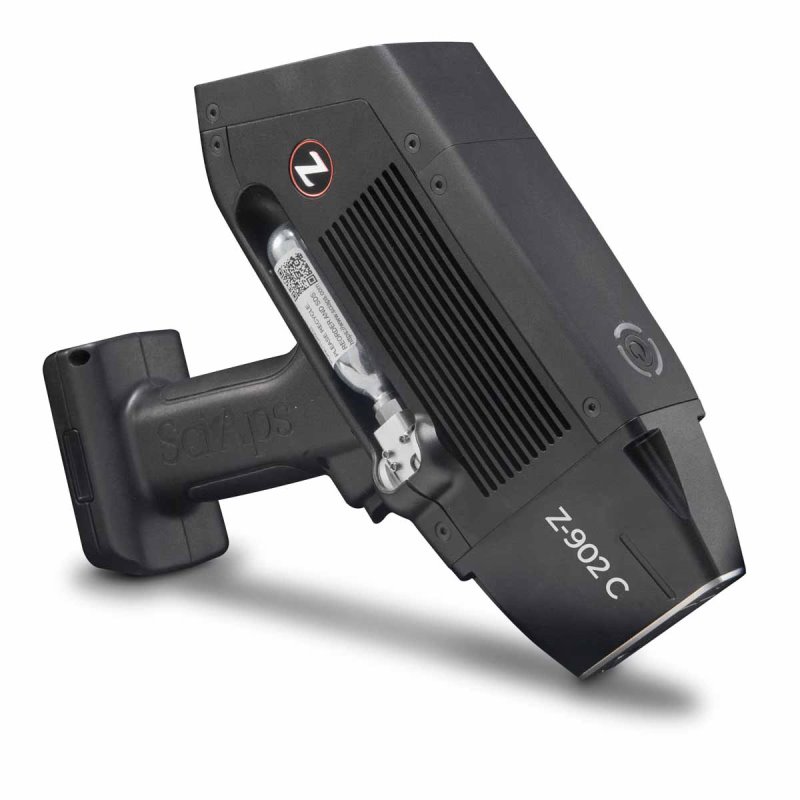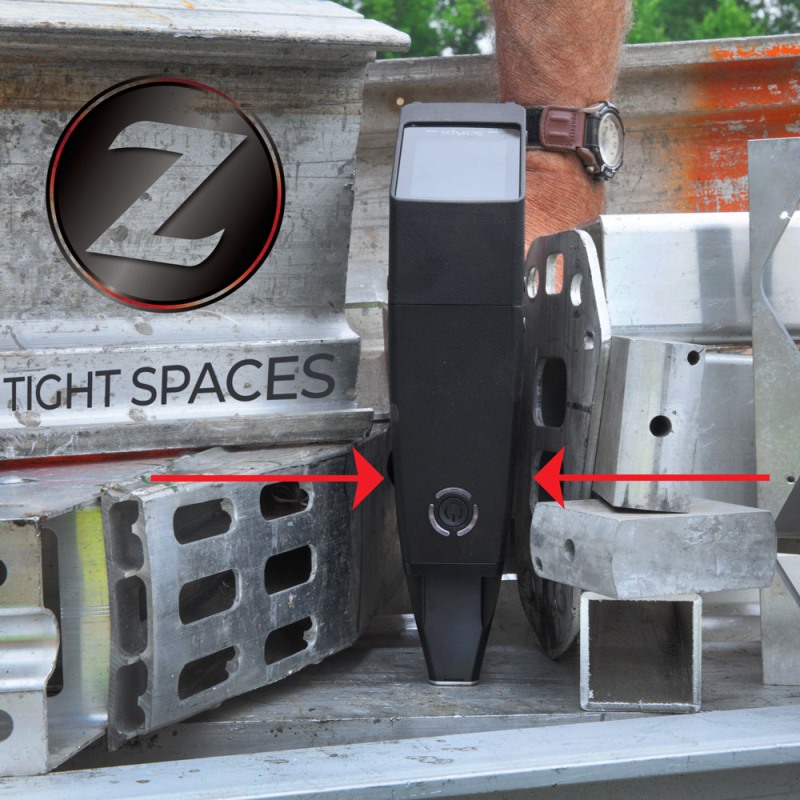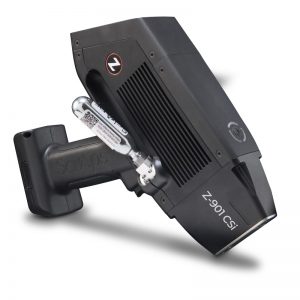Carbon LIBS Analyzer Z-902C SCIAPS
The world’s first handheld analyzer to deliver carbon content just got better
SKU: Z-902C
Description
The key to rock solid, in-field carbon analysis for alloys.
- Identification of stainless steels and low alloy steels, including carbon analysis down to 70 ppm and instant CE (carbon equivalents) calculations.
- Powerful laser, on-board argon purge and high resolution spectrometer are built for carbon.
- Narrow profile for accessing the tightest spaces, aerospace-grade aluminum body for improved performance in high ambient temperatures, and re-designed user-interface. The most usable platform on the market, at only 4.35 lbs. (1.97 kg).
Spectrometer range 190 nm – 420 nm. Includes a second, dedicated spectrometer for superior resolution in the 190 – 230 nm range for carbon.
PMI and NDT
Confirm alloy type and grade 300 series stainless steels into L, H, and S series. Carbon equivalent for welding. Material verification pre- and post-fabrication. Validating mill test reports. Material verification in chemical plants and refineries. Re-rating vessels.
Pipeline integrity management
Grading. Determining carbon equivalents. Validating MTRs.
Steel production
Screen incoming scrap material. In-process quality control. Resolving material mix-ups. Rapid screening of material at EAF for heat compliance.
The essentials for Carbon Analysis in Alloy with Handheld LIBS
- High-purity Argon and Purge
Argon purge is essential for quantitative analysis with LIBS and OES, and for carbon it’s critical. SciAps patented Opti-Purge technique is a key component for measuring carbon accurately. Opti-Purge delivers argon exactly where it’s needed and uses about 1,000 times less argon than a spark OES, allowing for a user-replaceable canister. Operators can analyze up to 600 samples with the argon canister for most alloy testing, and 125-200 samples for carbon analysis. - High laser Pulse Energy and Frequency
The SciAps laser delivers 5-6 mJ/pulse on the sample, with a 50 Hz repetition rate. As any user of spark OES knows, sample prep is critical for carbon analysis—a good grind and a good pre-burn are as critical for LIBS as for spark OES. SciAps high energy and high rep rate laser (50 Hz) rapidly burns off surface contamination in order to provide a good analysis. - Laser Raster
Rastering is critical for accurate carbon tests with LIBS. The Z moves the laser to 6 distinct locations and analyzes each spot for 0.5 seconds for every 3-second test. The laser is typically 50 um diameter beam. On that scale, micro inclusions in the alloys and the grain structure of the alloy can impact the analysis. By averaging across six unique locations, the system collects data that is representative of the alloy, not just an individual location. - Analysis Averaging
Multi-shot averaging and data rejection are critical to getting the best carbon tests. The combination of these two features, known as analysis averaging, allows the operator to (optionally) reject test data with significant point-by-point discrepancies then automatically create a final result. - Micro-Camera and LED Spotlight
Proper alignment is critical to getting good analysis. Take out the guess work with SciAps micro-camera and LED Spotlight. The camera shows the sample in high resolution and ensures that the instrument is positioned correctly; LED Spotlight shows exactly where the laser will burn the sample. Get a good burn every time. - Argon: Cost of Operation
Argon costs just pennies per test, far less expensive than spark OES and much more convenient. What does that mean in real terms? It depends if you are doing carbon tests or general alloy tests. You can expect to get about 100 tests per canister for carbon, and 600 tests for general alloy.
- Spectral Range: 190-420nm
- Processing Electronics: ARM Quad Cortex -A53 1.2GHz memory: 2 GB LPDDR3, 16 GB eMMC
- Calibrations:
Aluminum: Be, Mg, Al, Si, Ti, V, Cr, Mn, Fe, Ni, Cu, Zn, Zr, Pb, Bi, Ag, SnTitanium Base: Al, Ti, V, Cr, Fe, Cu, Zr, Nb, Mo, SnLAS Base: C, Al, Si, Ti, V, Cr, Mn, Fe, Cu, Ni, Nb, Mo, Pb
Stainless Steels: C, Al, Si, Ti, V, Cr, Mn, Ni, Fe, Ni, Cu, Nb, Mo, W
Nickel Base: Al, Si, Ti, Cr, Mn, Fe, Co, Ni, Cu, Nb, Mo, W
Copper Base: Be, Al, Si, Cr, Mn, Fe, Ni, Cu, Zn, Ag, Sn, Pb, Bi
Cobalt Base: Al, Si, Ti, Cr, Mn, Fe, Co, Ni, Cu, Nb, Mo, W
Specialty Bases: Mg, V, Cr, Mn, Co, Zn, Zr, Nb, Mo, Ag, Sn, Hf, Ta, W, Re, Pb, S - Data Storage: Results Storage: 32 GB SD
- Dimensions: 10.75 x 2.875 x 8.625 inches
- Display: 2.7-inch high-brightness color touchscreen, readable in all conditions. Rear-facing display for easy results viewing
- Power: On board rechargeable Li-ion battery, rechargeable inside device or with external charger, AC power
- Connectivity: Built on Google’s Android platform for real-time data exporting, including built-in WiFi (IEEE 802.11b/g/n), Bluetooth (BR/EDR+BLE), GPS and USB-C to connect to virtually any information management system
- Security: Password protected. Multi-user support with configurable access
- Regulatory: CE, RoHS, USFDA registered. Class 3b laser. Sample sensor on board, allows for operation under Class 1 conditions subject to local LSO approval
- Sample viewing: Integrated camera and laser target indicator before and during analysis provide proper sample alignment. Includes 2nd “macro camera” for scanning QR or barcodes and for photo-documentation and report generation
- Laser Raster: On-board Y stage for rastering laser to discrete locations for targeted analysis or averaging
- Atmosphere: SciAps proprietary Opti-Purge inert argon environment improves spectral signal-to-noise ratio; improves performance in UV range
- Calibration Check: Internal 316 stainless check standard for calibration verification and wavelength scale validation
- Drift Connection: On-board automated drift correction software with factory or user-provided reference materials
- Grade Library: 500+ grades, multi-library support, libraries may be added or edited






